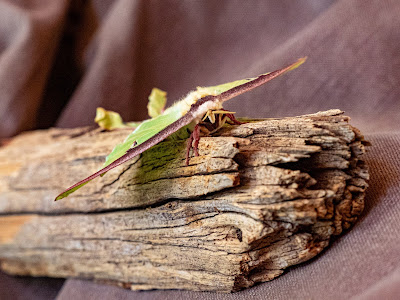We see many species of birds at the farm, and quite a few insects, too. Some of these are of the unwelcome variety…gnats and mosquitoes…but there are butterflies as well. They flutter from flower to flower so quickly that it’s hard to get a nice image of one. There are also moths that flutter against the windows, trying to get to the light. A couple of week ago, my nieces and their kids spotted one we rarely see, a Luna moth, Actias luna. We think this one is a male.
Found in North America from east of the Great Plains to the coast, and from Florida to Maine. They are from a group commonly known as giant silk moths. The Luna moths are recognized by their lime-green wings with “eye” spots, and a white, hairy, body. They are not rare, but are rarely seen because of their short adult life span (only 7-10 days) and nocturnal flying habits. They are hard to spot in the wild because they so closely resemble green leaves. Also, their forewings are dark, like twigs, and the forewing spots look like emerging buds.
They also have “acoustic camouflage.” The long, twisting tails on their hindwing help them to avoid capture by echolocating bats. Research at the University of Washington and Johns Hopkins University found that the tails not only shift the location of the echos, but also scatter the reflected sounds, making it hard for the bats to make a meal of them.
In northern areas, Luna moths have only one generation per year. Farther south, there may be two or three generations. The adult moths have only vestigial mouthparts and no digestive system. They therefore do not eat in their adult form and instead rely on energy stored up as caterpillars.
Their sole purpose in life is to reproduce. They usually mate after midnight, and the females begin laying eggs by the following night and continue for several more nights. The eggs hatch after another week and the cycle begins again.
This moth was found during the day, and hardly moved at all, so we assumed it was near the end of its life cycle. I took the opportunity to get several photos, then took it outside at dusk. It surprised me by flying away when I tried to place it on a tree, so maybe it still had things to do, places to go and other Luna moths to see. At any rate, we were so fortunate to see it during its short life.





Wow, just now seeing these photos of the luna moth and warblers! Incredible!!!
ReplyDelete